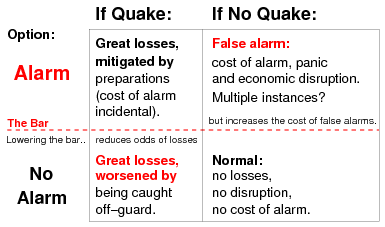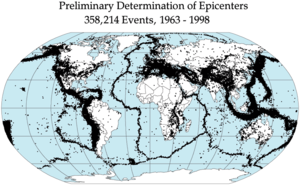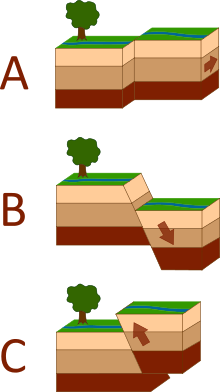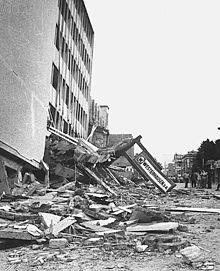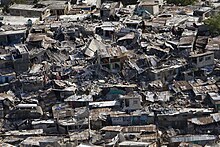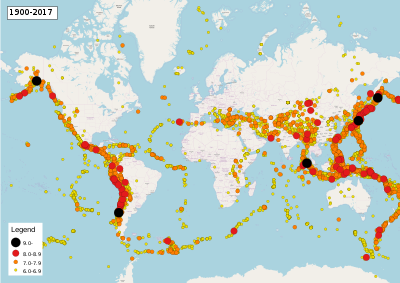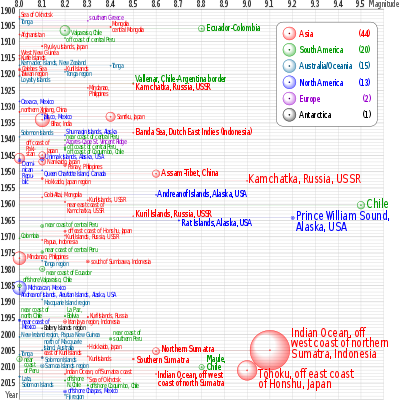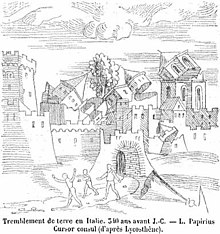Earthquake prediction is a branch of the science of seismology concerned with the specification of the time, location, and magnitude of future earthquakes within stated limits, and particularly "the determination of parameters for the next strong earthquake to occur in a region. Earthquake prediction is sometimes distinguished from earthquake forecasting, which can be defined as the probabilistic assessment of general earthquake hazard, including the frequency and magnitude of damaging earthquakes in a given area over years or decades. Prediction can be further distinguished from earthquake warning systems, which upon detection of an earthquake, provide a real-time warning of seconds to neighboring regions that might be affected.
In the 1970s, scientists were optimistic that a practical method for predicting earthquakes would soon be found, but by the 1990s continuing failure led many to question whether it was even possible. Demonstrably successful predictions of large earthquakes have not occurred and the few claims of success are controversial. For example, the most famous claim of a successful prediction is that alleged for the 1975 Haicheng earthquake. A later study said that there was no valid short-term prediction. Extensive searches have reported many possible earthquake precursors, but, so far, such precursors have not been reliably identified across significant spatial and temporal scales. While part of the scientific community hold that, taking into account non-seismic precursors and given enough resources to study them extensively, prediction might be possible, most scientists are pessimistic and some maintain that earthquake prediction is inherently impossible.
Evaluating earthquake predictions
Predictions are deemed significant if they can be shown to be successful beyond random chance. Therefore, methods of statistical hypothesis testing are used to determine the probability that an earthquake such as is predicted would happen anyway (the null hypothesis). The predictions are then evaluated by testing whether they correlate with actual earthquakes better than the null hypothesis.
In many instances, however, the statistical nature of earthquake
occurrence is not simply homogeneous. Clustering occurs in both space
and time.
In southern California about 6% of M ≥ 3.0 earthquakes are "followed by
an earthquake of larger magnitude within 5 days and 10 km." In central Italy 9.5% of M≥3.0 earthquakes are followed by a larger event within 48 hours and 30 km.
While such statistics are not satisfactory for purposes of prediction
(giving ten to twenty false alarms for each successful prediction) they
will skew the results of any analysis that assumes that earthquakes
occur randomly in time, for example, as realized from a Poisson process.
It has been shown that a "naive" method based solely on clustering can
successfully predict about 5% of earthquakes; "far better than
'chance'".
As the purpose of short-term prediction is to enable emergency
measures to reduce death and destruction, failure to give warning of a
major earthquake, that does occur, or at least an adequate evaluation of
the hazard, can result in legal liability, or even political purging.
For example, it has been reported that members of the Chinese Academy of
Sciences were purged for "having ignored scientific predictions of the
disastrous Tangshan earthquake of summer 1976." Wade 1977.
Following the L'Aquila earthquake of 2009, seven scientists and
technicians in Italy were convicted of manslaughter, but not so much for
failing to predict the 2009 L'Aquila Earthquake (where some 300 people died) as for giving undue assurance to the populace – one victim called it "anaesthetizing" – that there would not be a serious earthquake, and therefore no need to take precautions.
But warning of an earthquake that does not occur also incurs a cost:
not only the cost of the emergency measures themselves, but of civil and
economic disruption.
False alarms, including alarms that are canceled, also undermine the
credibility, and thereby the effectiveness, of future warnings. In 1999 it was reported (Saegusa 1999)
that China was introducing "tough regulations intended to stamp out
‘false’ earthquake warnings, in order to prevent panic and mass
evacuation of cities triggered by forecasts of major tremors." This was
prompted by "more than 30 unofficial earthquake warnings ... in the past
three years, none of which has been accurate."
The acceptable trade-off between missed quakes and false alarms depends
on the societal valuation of these outcomes. The rate of occurrence of
both must be considered when evaluating any prediction method.
In a 1997 study of the cost-benefit ratio of earthquake
prediction research in Greece, Stathis Stiros suggested that even a
(hypothetical) excellent prediction method would be of questionable
social utility, because "organized evacuation of urban centers is
unlikely to be successfully accomplished", while "panic and other
undesirable side-effects can also be anticipated." He found that
earthquakes kill less than ten people per year in Greece (on average),
and that most of those fatalities occurred in large buildings with
identifiable structural issues. Therefore, Stiros stated that it would
be much more cost-effective to focus efforts on identifying and
upgrading unsafe buildings. Since the death toll on Greek highways is
more than 2300 per year on average, he argued that more lives would also
be saved if Greece's entire budget for earthquake prediction had been
used for street and highway safety instead.
Prediction methods
Earthquake
prediction is an immature science—it has not yet led to a successful
prediction of an earthquake from first physical principles. Research
into methods of prediction therefore focus on empirical analysis, with
two general approaches: either identifying distinctive precursors to earthquakes, or identifying some kind of geophysical trend or pattern in seismicity that might precede a large earthquake.
Precursor methods are pursued largely because of their potential
utility for short-term earthquake prediction or forecasting, while
'trend' methods are generally thought to be useful for forecasting, long
term prediction (10 to 100 years time scale) or intermediate term
prediction (1 to 10 years time scale).
Precursors
An earthquake precursor is an anomalous phenomenon that might give effective warning of an impending earthquake. Reports of these – though generally recognized as such only after the event – number in the thousands, some dating back to antiquity. There have been around 400 reports of possible precursors in scientific literature, of roughly twenty different types, running the gamut from aeronomy to zoology. None have been found to be reliable for the purposes of earthquake prediction.
In the early 1990, the IASPEI solicited nominations for a
Preliminary List of Significant Precursors. Forty nominations were made,
of which five were selected as possible significant precursors, with
two of those based on a single observation each.
After a critical review of the scientific literature the International Commission on Earthquake Forecasting for Civil Protection (ICEF) concluded in 2011 there was "considerable room for methodological improvements in this type of research."
In particular, many cases of reported precursors are contradictory,
lack a measure of amplitude, or are generally unsuitable for a rigorous
statistical evaluation. Published results are biased towards positive
results, and so the rate of false negatives (earthquake but no
precursory signal) is unclear.
Animal behavior
For
centuries there have been anecdotal accounts of anomalous animal
behavior preceding and associated with earthquakes. In cases where
animals display unusual behavior some tens of seconds prior to a quake,
it has been suggested they are responding to the P-wave. These travel through the ground about twice as fast as the S-waves that cause most severe shaking.
They predict not the earthquake itself — that has already happened —
but only the imminent arrival of the more destructive S-waves.
It has also been suggested that unusual behavior hours or even
days beforehand could be triggered by foreshock activity at magnitudes
that most people do not notice. Another confounding factor of accounts of unusual phenomena is skewing due to "flashbulb memories":
otherwise unremarkable details become more memorable and more
significant when associated with an emotionally powerful event such as
an earthquake.
A study that attempted to control for these kinds of factors found an
increase in unusual animal behavior (possibly triggered by foreshocks)
in one case, but not in four other cases of seemingly similar
earthquakes.
Dilatancy–diffusion
In
the 1970s the dilatancy–diffusion hypothesis was highly regarded as
providing a physical basis for various phenomena seen as possible
earthquake precursors. It was based on "solid and repeatable evidence" from laboratory experiments that highly stressed crystalline rock experienced a change in volume, or dilatancy,
which causes changes in other characteristics, such as seismic velocity
and electrical resistivity, and even large-scale uplifts of topography.
It was believed this happened in a 'preparatory phase' just prior to
the earthquake, and that suitable monitoring could therefore warn of an
impending quake.
Detection of variations in the relative velocities of the primary
and secondary seismic waves – expressed as Vp/Vs – as they passed
through a certain zone was the basis for predicting the 1973 Blue
Mountain Lake (NY) and 1974 Riverside (CA) quake.
Although these predictions were informal and even trivial, their
apparent success was seen as confirmation of both dilatancy and the
existence of a preparatory process, leading to what were subsequently
called "wildly over-optimistic statements" that successful earthquake prediction "appears to be on the verge of practical reality."
However, many studies questioned these results,
and the hypothesis eventually languished. Subsequent study showed it
"failed for several reasons, largely associated with the validity of the
assumptions on which it was based", including the assumption that
laboratory results can be scaled up to the real world. Another factor was the bias of retrospective selection of criteria. Other studies have shown dilatancy to be so negligible that Main et al. 2012
concluded: "The concept of a large-scale 'preparation zone' indicating
the likely magnitude of a future event, remains as ethereal as the ether
that went undetected in the Michelson–Morley experiment."
Changes in Vp/Vs
Vp is the symbol for the velocity of a seismic "P" (primary or pressure) wave passing through rock, while Vs
is the symbol for the velocity of the "S" (secondary or shear) wave.
Small-scale laboratory experiments have shown that the ratio of these
two velocities – represented as Vp/Vs
– changes when rock is near the point of fracturing. In the 1970s it
was considered a likely breakthrough when Russian seismologists reported
observing such changes (later discounted.) in the region of a subsequent earthquake.
This effect, as well as other possible precursors, has been attributed
to dilatancy, where rock stressed to near its breaking point expands
(dilates) slightly.
Study of this phenomenon near Blue Mountain Lake in New York State led to a successful albeit informal prediction in 1973, and it was credited for predicting the 1974 Riverside (CA) quake. However, additional successes have not followed, and it has been suggested that these predictions were a flukes. A Vp/Vs anomaly was the basis of a 1976 prediction of a M 5.5 to 6.5 earthquake near Los Angeles, which failed to occur. Other studies relying on quarry blasts (more precise, and repeatable) found no such variations,
while an analysis of two earthquakes in California found that the
variations reported were more likely caused by other factors, including
retrospective selection of data. Geller (1997) noted that reports of significant velocity changes have ceased since about 1980.
Radon emissions
Most
rock contains small amounts of gases that can be isotopically
distinguished from the normal atmospheric gases. There are reports of
spikes in the concentrations of such gases prior to a major earthquake;
this has been attributed to release due to pre-seismic stress or
fracturing of the rock. One of these gases is radon, produced by radioactive decay of the trace amounts of uranium present in most rock.
Radon is useful as a potential earthquake predictor because it is radioactive and thus easily detected, and its short half-life (3.8 days) makes radon levels sensitive to short-term fluctuations. A 2009 review
found 125 reports of changes in radon emissions prior to 86 earthquakes
since 1966. But as the ICEF found in its review, the earthquakes with
which these changes are supposedly linked were up to a thousand
kilometers away, months later, and at all magnitudes. In some cases the
anomalies were observed at a distant site, but not at closer sites.
The ICEF found "no significant correlation".
Another review concluded that in some cases changes in radon levels
preceded an earthquake, but a correlation is not yet firmly established.
Electromagnetic anomalies
Observations of electromagnetic disturbances and their attribution to the earthquake failure process go back as far as the Great Lisbon earthquake
of 1755, but practically all such observations prior to the mid-1960s
are invalid because the instruments used were sensitive to physical
movement.
Since then various anomalous electrical, electric-resistive, and
magnetic phenomena have been attributed to precursory stress and strain
changes that precede earthquakes, raising hopes for finding a reliable earthquake precursor.
While a handful of researchers have gained much attention with either
theories of how such phenomena might be generated, claims of having
observed such phenomena prior to an earthquake, no such phenomena has
been shown to be an actual precursor.
A 2011 review
found the "most convincing" electromagnetic precursors to be ULF
magnetic anomalies, such as the Corralitos event (discussed below)
recorded before the 1989 Loma Prieta earthquake. However, it is now
believed that observation was a system malfunction. Study of the closely
monitored 2004 Parkfield earthquake found no evidence of precursory
electromagnetic signals of any type; further study showed that
earthquakes with magnitudes less than 5 do not produce significant
transient signals. The International Commission on Earthquake Forecasting for Civil Protection (ICEF) considered the search for useful precursors to have been unsuccessful.
* VAN seismic electric signals
The most touted, and most criticized, claim of an electromagnetic precursor is the VAN method of physics professors Panayiotis Varotsos, Kessar Alexopoulos and Konstantine Nomicos (VAN) of the University of Athens. In a 1981 paper
they claimed that by measuring geoelectric voltages – what they called
"seismic electric signals" (SES) – they could predict earthquakes of
magnitude larger than 2.8 within all of Greece up to seven hours
beforehand.
In 1984 they claimed there was a "one-to-one correspondence" between SES and earthquakes – that is, that "every sizable EQ is preceded by an SES and inversely every SES is always followed by an EQ the magnitude and the epicenter of which can be reliably predicted"
– the SES appearing between 6 and 115 hours before the earthquake. As
proof of their method they claimed a series of successful predictions.
Although their report was "saluted by some as a major
breakthrough" – one enthusiastic supporter (Uyeda) was reported as
saying "VAN is the biggest invention since the time of Archimedes" – among seismologists it was greeted by a "wave of generalized skepticism". In 1996 a paper VAN submitted to the journal Geophysical Research Letters
was given an unprecedented public peer-review by a broad group of
reviewers, with the paper and reviews published in a special issue;
the majority of reviewers found the methods of VAN to be flawed.
Additional criticism was raised the same year in a public debate between
some of the principals.
A primary criticism was that the method is geophysically implausible and scientifically unsound. Additional objections included the demonstrable falsity of the claimed one-to-one relationship of earthquakes and SES, the unlikelihood of a precursory process generating signals stronger than any observed from the actual earthquakes, and the very strong likelihood that the signals were man-made.
Further work in Greece has tracked SES-like "anomalous transient
electric signals" back to specific human sources, and found that such
signals are not excluded by the criteria used by VAN to identify SES.
The validity of the VAN method, and therefore the predictive
significance of SES, was based primarily on the empirical claim of
demonstrated predictive success. Numerous weaknesses have been uncovered in the VAN methodology, and in 2011 the ICEF concluded that the prediction capability claimed by VAN could not be validated. Most seismologists consider VAN to have been "resoundingly debunked".
* Corralitos anomaly
Probably
the most celebrated seismo-electromagnetic event ever, and one of the
most frequently cited examples of a possible earthquake precursor, is
the 1989 Corralitos anomaly. In the month prior to the 1989 Loma Prieta earthquake measurements of the earth's magnetic field at ultra-low frequencies by a magnetometer in Corralitos, California,
just 7 km from the epicenter of the impending earthquake, started
showing anomalous increases in amplitude. Just three hours before the
quake the measurements soared to about thirty times greater than normal,
with amplitudes tapering off after the quake. Such amplitudes had not
been seen in two years of operation, nor in a similar instrument located
54 km away. To many people such apparent locality in time and space
suggested an association with the earthquake.
Additional magnetometers were subsequently deployed across
northern and southern California, but after ten years, and several large
earthquakes, similar signals have not been observed. More recent
studies have cast doubt on the connection, attributing the Corralitos
signals to either unrelated magnetic disturbance or, even more simply, to sensor-system malfunction.
* Freund physics
In
his investigations of crystalline physics, Friedemann Freund found that
water molecules embedded in rock can dissociate into ions if the rock
is under intense stress. The resulting charge carriers can generate
battery currents under certain conditions. Freund suggested that perhaps
these currents could be responsible for earthquake precursors such as
electromagnetic radiation, earthquake lights and disturbances of the
plasma in the ionosphere. The study of such currents and interactions is known as "Freund physics".
Most seismologists reject Freund's suggestion that
stress-generated signals can be detected and put to use as precursors,
for a number of reasons. First, it is believed that stress does not
accumulate rapidly before a major earthquake, and thus there is no
reason to expect large currents to be rapidly generated. Secondly,
seismologists have extensively searched for statistically reliable
electrical precursors, using sophisticated instrumentation, and have not
identified any such precursors. And thirdly, water in the earth's crust
would cause any generated currents to be absorbed before reaching the
surface.
Trends
Instead
of watching for anomalous phenomena that might be precursory signs of an
impending earthquake, other approaches to predicting earthquakes look
for trends or patterns that lead to an earthquake. As these trends may
be complex and involve many variables, advanced statistical techniques
are often needed to understand them, therefore these are sometimes
called statistical methods. These approaches also tend to be more
probabilistic, and to have larger time periods, and so merge into
earthquake forecasting.
Elastic rebound
Even
the stiffest of rock is not perfectly rigid. Given a large force (such
as between two immense tectonic plates moving past each other) the
earth's crust will bend or deform. According to the elastic rebound theory of Reid (1910),
eventually the deformation (strain) becomes great enough that something
breaks, usually at an existing fault. Slippage along the break (an
earthquake) allows the rock on each side to rebound to a less deformed
state. In the process energy is released in various forms, including
seismic waves.
The cycle of tectonic force being accumulated in elastic deformation
and released in a sudden rebound is then repeated. As the displacement
from a single earthquake ranges from less than a meter to around 10
meters (for an M 8 quake), the demonstrated existence of large strike-slip displacements of hundreds of miles shows the existence of a long running earthquake cycle.
Characteristic earthquakes
The most studied earthquake faults (such as the Nankai megathrust, the Wasatch fault, and the San Andreas fault) appear to have distinct segments. The characteristic earthquake model postulates that earthquakes are generally constrained within these segments. As the lengths and other properties
of the segments are fixed, earthquakes that rupture the entire fault
should have similar characteristics. These include the maximum magnitude
(which is limited by the length of the rupture), and the amount of
accumulated strain needed to rupture the fault segment. Since
continuous plate motions cause the strain to accumulate steadily,
seismic activity on a given segment should be dominated by earthquakes
of similar characteristics that recur at somewhat regular intervals. For a given fault segment, identifying these characteristic earthquakes and timing their recurrence rate (or conversely return period) should therefore inform us about the next rupture; this is the approach generally used in forecasting seismic hazard. UCERF3 is a notable example of such a forecast, prepared for the state of California.
Return periods are also used for forecasting other rare events, such as
cyclones and floods, and assume that future frequency will be similar
to observed frequency to date.
The idea of characteristic earthquakes was the basis of the Parkfield prediction:
fairly similar earthquakes in 1857, 1881, 1901, 1922, 1934, and 1966
suggested a pattern of breaks every 21.9 years, with a standard
deviation of ±3.1 years.
Extrapolation from the 1966 event led to a prediction of an earthquake
around 1988, or before 1993 at the latest (at the 95% confidence
interval). The appeal of such a method is that the prediction is derived entirely from the trend,
which supposedly accounts for the unknown and possibly unknowable
earthquake physics and fault parameters. However, in the Parkfield case
the predicted earthquake did not occur until 2004, a decade late. This
seriously undercuts the claim that earthquakes at Parkfield are
quasi-periodic, and suggests the individual events differ sufficiently
in other respects to question whether they have distinct characteristics
in common.
The failure of the Parkfield prediction has raised doubt as to the validity of the characteristic earthquake model itself.
Some studies have questioned the various assumptions, including the key
one that earthquakes are constrained within segments, and suggested
that the "characteristic earthquakes" may be an artifact of selection
bias and the shortness of seismological records (relative to earthquake
cycles). Other studies have considered whether other factors need to be considered, such as the age of the fault.
Whether earthquake ruptures are more generally constrained within a
segment (as is often seen), or break past segment boundaries (also
seen), has a direct bearing on the degree of earthquake hazard:
earthquakes are larger where multiple segments break, but in relieving
more strain they will happen less often.
Seismic gaps
At
the contact where two tectonic plates slip past each other every
section must eventually slip, as (in the long-term) none get left
behind. But they do not all slip at the same time; different sections
will be at different stages in the cycle of strain (deformation)
accumulation and sudden rebound. In the seismic gap model the "next big
quake" should be expected not in the segments where recent seismicity
has relieved the strain, but in the intervening gaps where the
unrelieved strain is the greatest. This model has an intuitive appeal; it is used in long-term forecasting, and was the basis of a series of circum-Pacific (Pacific Rim) forecasts in 1979 and 1989–1991.
However, some underlying assumptions about seismic gaps are now
known to be incorrect. A close examination suggests that "there may be
no information in seismic gaps about the time of occurrence or the
magnitude of the next large event in the region"; statistical tests of the circum-Pacific forecasts shows that the seismic gap model "did not forecast large earthquakes well". Another study concluded that a long quiet period did not increase earthquake potential.
Seismicity patterns
Various heuristically derived algorithms have been developed for
predicting earthquakes. Probably the most widely known is the M8 family
of algorithms (including the RTP method) developed under the leadership
of Vladimir Keilis-Borok.
M8 issues a "Time of Increased Probability" (TIP) alarm for a large
earthquake of a specified magnitude upon observing certain patterns of
smaller earthquakes. TIPs generally cover large areas (up to a thousand
kilometers across) for up to five years.
Such large parameters have made M8 controversial, as it is hard to
determine whether any hits that happened were skillfully predicted, or
only the result of chance.
M8 gained considerable attention when the 2003 San Simeon and Hokkaido earthquakes occurred within a TIP.
In 1999, Keilis-Borok's group published a claim to have achieved
statistically significant intermediate-term results using their M8 and
MSc models, as far as world-wide large earthquakes are regarded. However, Geller et al.
are skeptical of prediction claims over any period shorter than 30
years. A widely publicized TIP for an M 6.4 quake in Southern California
in 2004 was not fulfilled, nor two other lesser known TIPs.
A deep study of the RTP method in 2008 found that out of some twenty
alarms only two could be considered hits (and one of those had a 60%
chance of happening anyway).
It concluded that "RTP is not significantly different from a naïve
method of guessing based on the historical rates [of] seismicity."
Accelerating moment release (AMR,
"moment" being a measurement of seismic energy), also known as
time-to-failure analysis, or accelerating seismic moment release (ASMR),
is based on observations that foreshock activity prior to a major
earthquake not only increased, but increased at an exponential rate. In other words, a plot of the cumulative number of foreshocks gets steeper just before the main shock.
Following formulation by Bowman et al. (1998) into a testable hypothesis, and a number of positive reports, AMR seemed promising
despite several problems. Known issues included not being detected for
all locations and events, and the difficulty of projecting an accurate
occurrence time when the tail end of the curve gets steep. But rigorous testing has shown that apparent AMR trends likely result from how data fitting is done, and failing to account for spatiotemporal clustering of earthquakes.
The AMR trends are therefore statistically insignificant. Interest in
AMR (as judged by the number of peer-reviewed papers) has fallen off
since 2004.
Notable predictions
These
are predictions, or claims of predictions, that are notable either
scientifically or because of public notoriety, and claim a scientific or
quasi-scientific basis. As many predictions are held confidentially, or
published in obscure locations, and become notable only when they are
claimed, there may be a selection bias in that hits get more attention than misses.
The predictions listed here are discussed in Hough's book and Geller's paper.
1975: Haicheng, China
The M 7.3 1975 Haicheng earthquake is the most widely cited "success" of earthquake prediction.
Study of seismic activity in the region led the Chinese authorities to
issue a medium-term prediction in June 1974. The political authorities
therefore ordered various measures taken, including enforced evacuation
of homes, construction of "simple outdoor structures", and showing of
movies out-of-doors. The quake, striking at 19:36, was powerful enough
to destroy or badly damage about half of the homes. However, the
"effective preventative measures taken" were said to have kept the death
toll under 300 in an area with population of about 1.6 million, where
otherwise tens of thousands of fatalities might have been expected.
However, although a major earthquake occurred, there has been
some skepticism about the narrative of measures taken on the basis of a
timely prediction. This event occurred during the Cultural Revolution,
when "belief in earthquake prediction was made an element of
ideological orthodoxy that distinguished the true party liners from
right wing deviationists".
Recordkeeping was disordered, making it difficult to verify details,
including whether there was any ordered evacuation. The method used for
either the medium-term or short-term predictions (other than "Chairman
Mao's revolutionary line") has not been specified. The evacuation may have been spontaneous, following the strong (M 4.7) foreshock that occurred the day before.
A 2006 study that had access to an extensive range of records
found that the predictions were flawed. "In particular, there was no
official short-term prediction, although such a prediction was made by
individual scientists."
Also: "it was the foreshocks alone that triggered the final decisions
of warning and evacuation". They estimated that 2,041 lives were lost.
That more did not die was attributed to a number of fortuitous
circumstances, including earthquake education in the previous months
(prompted by elevated seismic activity), local initiative, timing
(occurring when people were neither working nor asleep), and local style
of construction. The authors conclude that, while unsatisfactory as a
prediction, "it was an attempt to predict a major earthquake that for
the first time did not end up with practical failure."
1981: Lima, Peru (Brady)
In 1976 Brian Brady, a physicist then at the U.S. Bureau of Mines,
where he had studied how rocks fracture, "concluded a series of four
articles on the theory of earthquakes with the deduction that strain
building in the subduction zone [off-shore of Peru] might result in an
earthquake of large magnitude within a period of seven to fourteen years
from mid November 1974."
In an internal memo written in June 1978 he narrowed the time window to
"October to November, 1981", with a main shock in the range of 9.2±0.2. In a 1980 memo he was reported as specifying "mid-September 1980".
This was discussed at a scientific seminar in San Juan, Argentina, in
October 1980, where Brady's colleague, W. Spence, presented a paper.
Brady and Spence then met with government officials from the U.S. and
Peru on 29 October, and "forecast a series of large magnitude
earthquakes in the second half of 1981."
This prediction became widely known in Peru, following what the U.S.
embassy described as "sensational first page headlines carried in most
Lima dailies" on January 26, 1981.
On 27 January 1981, after reviewing the Brady-Spence prediction, the U.S. National Earthquake Prediction Evaluation Council
(NEPEC) announced it was "unconvinced of the scientific validity" of
the prediction, and had been "shown nothing in the observed seismicity
data, or in the theory insofar as presented, that lends substance to the
predicted times, locations, and magnitudes of the earthquakes." It went
on to say that while there was a probability of major earthquakes at
the predicted times, that probability was low, and recommend that "the
prediction not be given serious consideration."
Unfazed,
Brady subsequently revised his forecast, stating there would be at
least three earthquakes on or about July 6, August 18 and September 24,
1981,
leading one USGS official to complain: "If he is allowed to continue
to play this game ... he will eventually get a hit and his theories will
be considered valid by many."
On June 28 (the date most widely taken as the date of the first
predicted earthquake), it was reported that: "the population of Lima
passed a quiet Sunday". The headline on one Peruvian newspaper: "NO PASO NADA" ("Nothing happens").
In July Brady formally withdrew his prediction on the grounds that prerequisite seismic activity had not occurred. Economic losses due to reduced tourism during this episode has been roughly estimated at one hundred million dollars.
1985–1993: Parkfield, U.S. (Bakun-Lindh)
The "Parkfield earthquake prediction experiment" was the most heralded scientific earthquake prediction ever. It was based on an observation that the Parkfield segment of the San Andreas Fault breaks regularly with a moderate earthquake of about M 6 every several decades: 1857, 1881, 1901, 1922, 1934, and 1966. More particularly, Bakun & Lindh (1985)
pointed out that, if the 1934 quake is excluded, these occur every 22
years, ±4.3 years. Counting from 1966, they predicted a 95% chance that
the next earthquake would hit around 1988, or 1993 at the latest. The National Earthquake Prediction Evaluation Council (NEPEC) evaluated this, and concurred.
The U.S. Geological Survey and the State of California therefore
established one of the "most sophisticated and densest nets of
monitoring instruments in the world",
in part to identify any precursors when the quake came. Confidence was
high enough that detailed plans were made for alerting emergency
authorities if there were signs an earthquake was imminent. In the words of the Economist: "never has an ambush been more carefully laid for such an event."
1993 came, and passed, without fulfillment. Eventually there was
an M 6.0 earthquake on the Parkfield segment of the fault, on 28
September 2004, but without forewarning or obvious precursors. While the experiment in catching an earthquake is considered by many scientists to have been successful, the prediction was unsuccessful in that the eventual event was a decade late.
1983–1995: Greece (VAN)
In 1981, the "VAN" group, headed by Panayiotis Varotsos, said that they
found a relationship between earthquakes and 'seismic electric signals'
(SES). In 1984 they presented a table of 23 earthquakes from 19 January
1983 to 19 September 1983, of which they claimed to have successfully
predicted 18 earthquakes. Other lists followed, such as their 1991 claim of predicting six out of seven earthquakes with Ms ≥ 5.5 in the period of 1 April 1987 through 10 August 1989, or five out of seven earthquakes with Ms ≥ 5.3 in the overlapping period of 15 May 1988 to 10 August 1989, In 1996 they published a "Summary of all Predictions issued from January 1st, 1987 to June 15, 1995", amounting to 94 predictions. Matching this against a list of "All earthquakes with MS(ATH)" and within geographical bounds including most of Greece
they come up with a list of 14 earthquakes they should have predicted.
Here they claim ten successes, for a success rate of 70%, but also a
false alarm rate of 89%.
The VAN predictions have been criticized on various grounds, including being geophysically implausible,
"vague and ambiguous", that "VAN’s ‘predictions’ never specify the
windows, and never state an unambiguous expiration date [and thus] VAN
are not making earthquake predictions in the first place", failing to satisfy prediction criteria, and retroactive adjustment of parameters.
It has also been objected that no one "can confidently state, except
in the most general terms, what the VAN hypothesis is, because the
authors of it have nowhere presented a thorough formulation of it."
A critical review of 14 cases where VAN claimed 10 successes
showed only one case where an earthquake occurred within the prediction
parameters.
The VAN predictions not only fail to do better than chance, but show "a
much better association with the events which occurred before them",
according to Mulargia and Gasperini. Other early reviews found that the VAN results, when evaluated by definite parameters, were statistically significant.
Both positive and negative views on VAN predictions from this period
were summarized in the 1996 book "A Critical Review of VAN" edited by
Sir James Lighthill and in a debate issue presented by the journal Geophysical Research Letters that was focused on the statistical significance of the VAN method. VAN had the opportunity to reply to their critics in those review publications.
In 2011, the ICEF reviewed the 1996 debate, and concluded that the
optimistic SES prediction capability claimed by VAN could not be
validated.
A crucial issue is the large and often indeterminate parameters of the predictions, such that some critics say these are not predictions, and should not be recognized as such.
Much of the controversy with VAN arises from this failure to adequately
specify these parameters. Some of their telegrams include predictions
of two distinct earthquake events, such as (typically) one earthquake
predicted at 300 km "N.W" of Athens, and another at 240 km "W", "with
magnitutes [sic] 5,3 and 5,8", with no time limit.
VAN has disputed the 'pessimistic' conclusions of their critics, but the critics have not relented. It was suggested that VAN failed to account for clustering of earthquakes, or that they interpreted their data differently during periods of greater seismic activity.
VAN has been criticized on several occasions for causing public panic and widespread unrest.
This has been exacerbated by the broadness of their predictions, which
cover large areas of Greece (up to 240 kilometers across, and often
pairs of areas),
much larger than the areas actually affected by earthquakes of the
magnitudes predicted (usually several tens of kilometers across).
Magnitudes are similarly broad: a predicted magnitude of "6.0"
represents a range from a benign magnitude 5.3 to a broadly destructive
6.7. Coupled with indeterminate time windows of a month or more, such predictions "cannot be practically utilized"
to determine an appropriate level of preparedness, whether to curtail
usual societal functioning, or even to issue public warnings. As an
instance of the quandary public officials face: in 1995 Professor
Varotsos reportedly filed a complaint with the public prosecutor
accusing government officials of negligence in not responding to his
supposed prediction of an earthquake. A government official was quoted
as saying "VAN's prediction was not of any use" in that it covered
two-thirds of the area of Greece.
1989: Loma Prieta, U.S.
The 1989 Loma Prieta earthquake (epicenter in the Santa Cruz Mountains northwest of San Juan Bautista, California) caused significant damage in the San Francisco Bay Area of California. The U.S. Geological Survey (USGS) reportedly claimed, twelve hours after the event, that it had "forecast" this earthquake in a report the previous year. USGS staff subsequently claimed this quake had been "anticipated"; various other claims of prediction have also been made.
Harris (1998)
reviewed 18 papers (with 26 forecasts) dating from 1910 "that variously
offer or relate to scientific forecasts of the 1989 Loma Prieta
earthquake." (In this case no distinction is made between a forecast, which is limited to a probabilistic estimate of an earthquake happening over some time period, and a more specific prediction.) None of these forecasts can be rigorously tested due to lack of specificity,
and where a forecast does bracket the correct time and location, the
window was so broad (e.g., covering the greater part of California for
five years) as to lose any value as a prediction. Predictions that came
close (but given a probability of only 30%) had ten- or twenty-year
windows.
One debated prediction came from the M8 algorithm used by Keilis-Borok and associates in four forecasts.
The first of these forecasts missed both magnitude (M 7.5) and time (a
five-year window from 1 January 1984, to 31 December 1988). They did get
the location, by including most of California and half of Nevada.
A subsequent revision, presented to the NEPEC, extended the time window
to 1 July 1992, and reduced the location to only central California;
the magnitude remained the same. A figure they presented had two more
revisions, for M ≥ 7.0 quakes in central California. The five-year time
window for one ended in July 1989, and so missed the Loma Prieta event;
the second revision extended to 1990, and so included Loma Prieta.
When discussing success or failure of prediction for the Loma
Prieta earthquake, some scientists argue that it did not occur on the San Andreas fault (the focus of most of the forecasts), and involved dip-slip (vertical) movement rather than strike-slip (horizontal) movement, and so was not predicted.
Other scientists argue that it did occur in the San Andreas fault zone,
and released much of the strain accumulated since the 1906 San
Francisco earthquake; therefore several of the forecasts were correct. Hough states that "most seismologists" do not believe this quake was predicted "per se". In a strict sense there were no predictions, only forecasts, which were only partially successful.
Iben Browning claimed to have predicted the Loma Prieta event, but (as will be seen in the next section) this claim has been rejected.
1990: New Madrid, U.S. (Browning)
Iben Browning
(a scientist with a Ph.D. degree in zoology and training as a
biophysicist, but no experience in geology, geophysics, or seismology)
was an "independent business consultant" who forecast long-term climate
trends for businesses.
He supported the idea (scientifically unproven) that volcanoes and
earthquakes are more likely to be triggered when the tidal force of the
sun and the moon coincide to exert maximum stress on the earth's crust (syzygy). Having calculated when these tidal forces maximize, Browning then "projected" what areas were most at risk for a large earthquake. An area he mentioned frequently was the New Madrid Seismic Zone at the southeast corner of the state of Missouri, the site of three very large earthquakes in 1811–12, which he coupled with the date of 3 December 1990.
Browning's reputation and perceived credibility were boosted when
he claimed in various promotional flyers and advertisements to have
predicted (among various other events) the Loma Prieta earthquake of 17 October 1989.
The National Earthquake Prediction Evaluation Council (NEPEC) formed an
Ad Hoc Working Group (AHWG) to evaluate Browning's prediction. Its
report (issued 18 October 1990) specifically rejected the claim of a
successful prediction of the Loma Prieta earthquake.
A transcript of his talk in San Francisco on 10 October showed he had
said: "there will probably be several earthquakes around the world,
Richter 6+, and there may be a volcano or two" – which, on a global
scale, is about average for a week – with no mention of any earthquake
in California.
Though the AHWG report disproved both Browning's claims of prior
success and the basis of his "projection", it made little impact after a
year of continued claims of a successful prediction. Browning's
prediction received the support of geophysicist David Stewart,
and the tacit endorsement of many public authorities in their
preparations for a major disaster, all of which was amplified by massive
exposure in the news media. Nothing happened on 3 December, and Browning died of a heart attack seven months later.
2004 & 2005: Southern California, U.S. (Keilis-Borok)
The M8 algorithm (developed under the leadership of Vladimir Keilis-Borok at UCLA) gained respect by the apparently successful predictions of the 2003 San Simeon and Hokkaido earthquakes.
Great interest was therefore generated by the prediction in early 2004
of a M ≥ 6.4 earthquake to occur somewhere within an area of southern
California of approximately 12,000 sq. miles, on or before 5 September
2004. In evaluating this prediction the California Earthquake Prediction Evaluation Council
(CEPEC) noted that this method had not yet made enough predictions for
statistical validation, and was sensitive to input assumptions. It
therefore concluded that no "special public policy actions" were
warranted, though it reminded all Californians "of the significant
seismic hazards throughout the state." The predicted earthquake did not occur.
A very similar prediction was made for an earthquake on or before
14 August 2005, in approximately the same area of southern California.
The CEPEC's evaluation and recommendation were essentially the same,
this time noting that the previous prediction and two others had not
been fulfilled. This prediction also failed.
2009: L'Aquila, Italy (Giuliani)
At 03:32 on 6 April 2009, the Abruzzo region of central Italy was rocked by a magnitude M 6.3 earthquake. In the city of L'Aquila
and surrounding area around 60,000 buildings collapsed or were
seriously damaged, resulting in 308 deaths and 67,500 people left
homeless.
Around the same time, it was reported that Giampaolo Giuliani had
predicted the earthquake, had tried to warn the public, but had been
muzzled by the Italian government.
Giampaolo Giuliani was a laboratory technician at the Laboratori Nazionali del Gran Sasso.
As a hobby he had for some years been monitoring radon using
instruments he had designed and built. Prior to the L'Aquila earthquake
he was unknown to the scientific community, and had not published any
scientific work. He had been interviewed on 24 March by an Italian-language blog, Donne Democratiche,
about a swarm of low-level earthquakes in the Abruzzo region that had
started the previous December. He said that this swarm was normal and
would diminish by the end of March. On 30 March, L'Aquila was struck by
a magnitude 4.0 temblor, the largest to date.
On 27 March Giuliani warned the mayor of L'Aquila there could be
an earthquake within 24 hours, and an earthquake M~2.3 occurred. On 29 March he made a second prediction.
He telephoned the mayor of the town of Sulmona, about 55 kilometers
southeast of L'Aquila, to expect a "damaging" – or even "catastrophic" –
earthquake within 6 to 24 hours. Loudspeaker vans were used to warn the
inhabitants of Sulmona to evacuate, with consequential panic. No quake
ensued and Giuliano was cited for inciting public alarm and enjoined
from making future public predictions.
After the L'Aquila event Giuliani claimed that he had found alarming rises in radon levels just hours before. He said he had warned relatives, friends and colleagues on the evening before the earthquake hit.
He was subsequently interviewed by the International Commission on
Earthquake Forecasting for Civil Protection, which found that Giuliani
had not transmitted a valid prediction of the mainshock to the civil
authorities before its occurrence.
Difficulty or impossibility
As the preceding examples show, the record of earthquake prediction has been disappointing. The optimism of the 1970s that routine prediction of earthquakes would be "soon", perhaps within ten years, was coming up disappointingly short by the 1990s, and many scientists began wondering why. By 1997 it was being positively stated that earthquakes can not be predicted, which led to a notable debate in 1999 on whether prediction of individual earthquakes is a realistic scientific goal.
Earthquake prediction may have failed only because it is "fiendishly difficult"
and still beyond the current competency of science. Despite the
confident announcement four decades ago that seismology was "on the
verge" of making reliable predictions,
there may yet be an underestimation of the difficulties. As early as
1978 it was reported that earthquake rupture might be complicated by
"heterogeneous distribution of mechanical properties along the fault",
and in 1986 that geometrical irregularities in the fault surface
"appear to exert major controls on the starting and stopping of
ruptures". Another study attributed significant differences in fault behavior to the maturity of the fault. These kinds of complexities are not reflected in current prediction methods.
Seismology may even yet lack an adequate grasp of its most central concept, elastic rebound theory.
A simulation that explored assumptions regarding the distribution of
slip found results "not in agreement with the classical view of the
elastic rebound theory". (This was attributed to details of fault
heterogeneity not accounted for in the theory.)
Earthquake prediction may be intrinsically impossible. It has been argued that the Earth is in a state of self-organized criticality "where any small earthquake has some probability of cascading into a large event".
It has also been argued on decision-theoretic grounds that "prediction
of major earthquakes is, in any practical sense, impossible."
That earthquake prediction might be intrinsically impossible has been strongly disputed But the best disproof of impossibility – effective earthquake prediction – has yet to be demonstrated.
